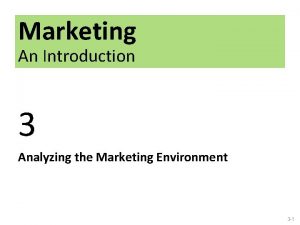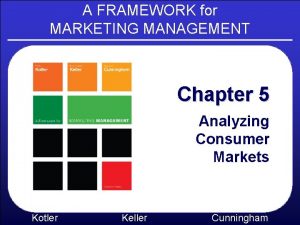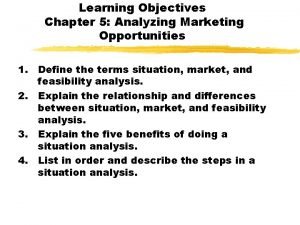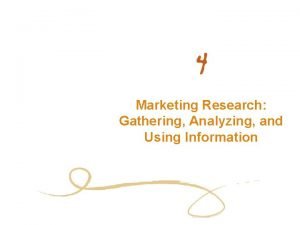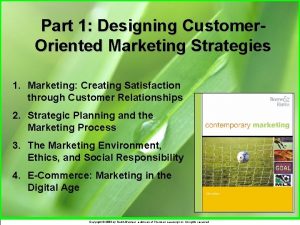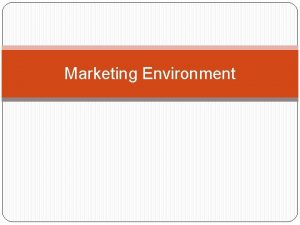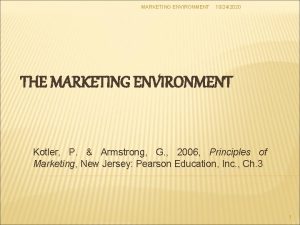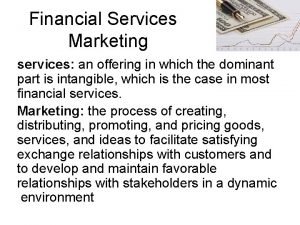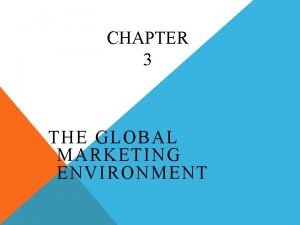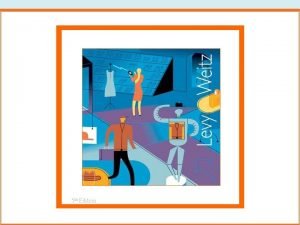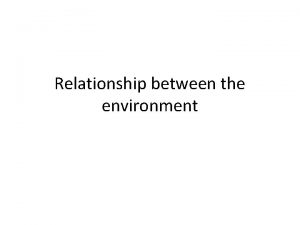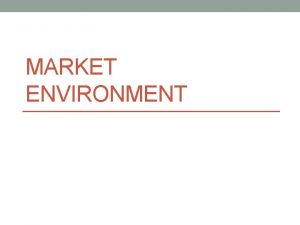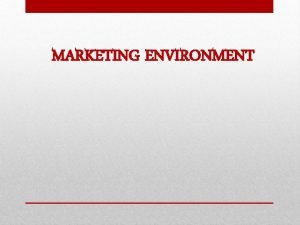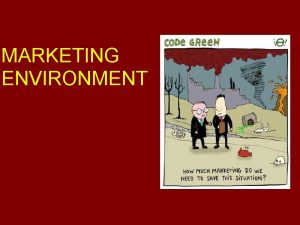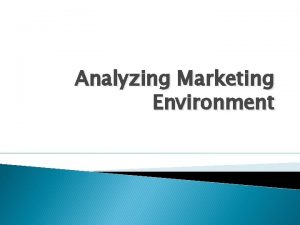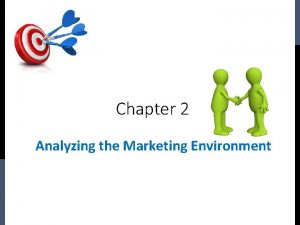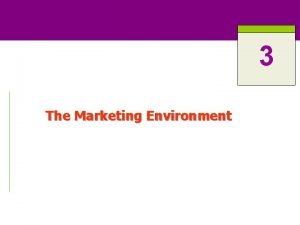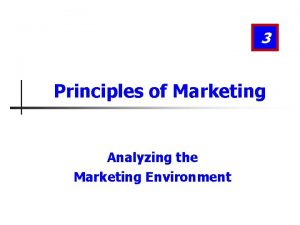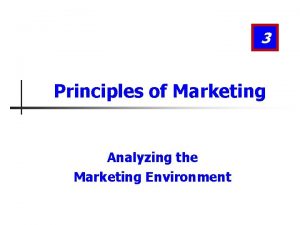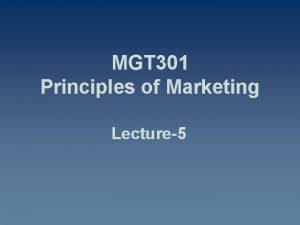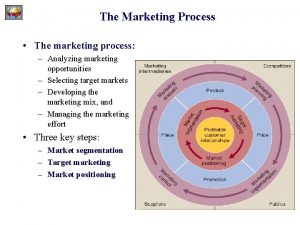LECTURE5 Analyzing the Marketing Environment Topic Outline Analyzing


































- Slides: 34

LECTURE-5 Analyzing the Marketing Environment

Topic Outline § Analyzing The Marketing Environment § The Company’s Micro-environment § The Company’s Macro-environment § Responding to the Marketing Environment

Analyzing the Marketing Environment • Micro-environment • Macro-environemnt – Demographic Environment – Economic Environment – Natural Environment – Technological Environment – Political and Social Environment – Cultural Environment – Responding to the Marketing Environment

The Marketing Environment The marketing environment includes the actors and forces outside marketing that affect marketing management’s ability to build and maintain successful relationships with customers

The Marketing Environment Microenvironment consists of the actors close to the company that affect its ability to serve its customers, the company, suppliers, marketing intermediaries, customer markets, competitors, and publics

The Company’s Microenvironment Actors in the Microenvironment

The Company’s Microenvironment The Company § § § Top management Finance R&D Purchasing Operations Accounting

The Company’s Microenvironment Suppliers • Provide the resources to produce goods and services • Treat as partners to provide customer value

The Company’s Microenvironment Marketing Intermediaries Help the company to promote, sell and distribute its products to final buyers

The Company’s Microenvironment Types of Marketing Intermediaries Resellers Physical distribution firms Marketing services agencies Financial intermediaries

The Company’s Microenvironment Competitors • Firms must gain strategic advantage by positioning their offerings against competitors’ offerings

The Company’s Microenvironment Publics § Any group that has an actual or potential interest in or impact on an organization’s ability to achieve its objectives – – – – Financial publics Media publics Government publics Citizen-action publics Local publics General public Internal publics

The Company’s Microenvironment Customers § § Consumer markets Business markets Government markets International markets

The Company’s Macroenvironment

The Company’s Macroenvironment Demographic Environment Demography: the study of human populations-size, density, location, age, gender, race, occupation, and other statistics § Demographic environment: involves people, and people make up markets § Demographic trends: shifts in age, family structure, geographic population, educational characteristics, and population diversity

The Company’s Macroenvironment Demographic Environment • Baby Boomers – Born 1946 to 1964 – Rethinking the purpose and value of their work, responsibilities, and relationships. – spending more carefully and planning to work longer – The wealthiest generation in U. S. history

The Company’s Macroenvironment Demographic Environment § Generation X includes people born between 1965 and 1976 § § High parental divorce rates Cautious economic outlook Less materialistic Family comes first

The Company’s Macroenvironment Demographic Environment • Millennials (gen Y or echo boomers) include those born between 1977 and 2000 – Most financially strapped generation – Higher unemployment and saddled with more debt – Comfortable with technology

The Company’s Macroenvironment Demographic Environment Generational marketing is important in segmenting people by lifestyle of life state instead of age

The Company’s Macroenvironment Demographic Environment • Changes in the Workforce – More educated – More white collar

The Company’s Macroenvironment Demographic Environment Increasing Diversity Markets are becoming more diverse – International – National • Includes: – Ethnicity – Disabled

The Company’s Macroenvironment Economic Environment Economic environment consists of factors that affect consumer purchasing power and spending patterns § Industrial economies are richer markets § Subsistence economies consume most of their own agriculture and industrial output

The Company’s Macroenvironment Economic Environment Changes in Consumer Spending Value marketing offering financially cautious buyers greater value— the right combination of quality and service at a fair price

The Company’s Macroenvironment Natural Environment Natural environment: natural resources that are needed as inputs by marketers or that are affected by marketing activities § Trends § § Increased shortages of raw materials Increased pollution Increased government intervention Increased environmentally sustainable strategies

The Company’s Macroenvironment Technological Environment § Most dramatic force in changing the marketplace § New products, opportunities § Concern for the safety of new products

The Company’s Macroenvironment Political and Social Environment § Legislation regulating business § Increased legislation § Changing government agency enforcement § Increased emphasis on ethics § Socially responsible behavior § Cause-related marketing

The Company’s Macroenvironment Cultural Environment Cultural environment consists of institutions and other forces that affect a society’s basic values, perceptions, and behaviors

The Company’s Macroenvironment Cultural Environment Persistence of Cultural Values Core beliefs and values are persistent and are passed on from parents to children and are reinforced by schools, religious institutions, businesses, and government Secondary beliefs and values are more open to change and include people’s views of themselves, others, organization, society, nature, and the universe

The Company’s Macroenvironment Cultural Environment Shifts in Secondary Cultural Values § People’s view of themselves § People vary in their emphasis on § serving themselves versus serving others. § People’s view of others § More “cocooning” – staying home, home cooked meals

The Company’s Macroenvironment Cultural Environment Shifts in Secondary Cultural Values • People’s view of organizations – Decline of loyalty toward companies • People’s view of society – Patriots defend it – Reformers want to change it – Malcontents want to leave it

The Company’s Macroenvironment Cultural Environment Shifts in Secondary Cultural Values § § People’s view of nature § Some feel ruled by it § Some feel in harmony with it § Some seek to master it People’s view of the universe § Renewed interest in spirituality § Developed more permanent values § family, community, earth, § spirituality, ethics

Responding to the Marketing Environment Views on Responding Uncontrollable • React and adapt to forces in the environment Proactive Reactive • Aggressive actions to affect forces in the environment • Watching and reacting to forces in the environment

Bibliography § Principles of Marketing by Philip Kotler & Gary Armstrong Fifteenth Edition, Published by Prentice Hall § Marketing Management – A South Asian Perspective by Philip Kotler, Kevin Lane Keller, Abraham Koshy & Mithileshwar Jha, 13 th Edition, Published by Pearson Education, Inc. § Principles and Practices of Marketing by Jobber, D. 4 th edition, Mc. Graw Hill International. § Principles of Advertising & IMC by Tom Duncan 2 nd Edition, Published by Mc. Graw-Hill Irwin.

The End "Life is like a combination lock; your job is to find the right numbers, in the right order so you can have anything you want. "
 Example of sentence outline
Example of sentence outline Marketing environment case study
Marketing environment case study Analyzing the marketing environment
Analyzing the marketing environment Analyzing the marketing environment
Analyzing the marketing environment Chapter 5 analyzing the marketing environment
Chapter 5 analyzing the marketing environment Concluding sentence
Concluding sentence Narrowed down topic
Narrowed down topic S
S A topic outline uses
A topic outline uses Leq format ap world
Leq format ap world Sentence outline
Sentence outline Digital topic outline
Digital topic outline Financial environment in business environment
Financial environment in business environment Analyzing marketing opportunities
Analyzing marketing opportunities Analyzing and using marketing information
Analyzing and using marketing information Marketing information and customer insights
Marketing information and customer insights Sports marketing environment matrix
Sports marketing environment matrix Service environment
Service environment Designing customer oriented marketing channels
Designing customer oriented marketing channels Consists of the actors and forces outside
Consists of the actors and forces outside Kotler’s environment model
Kotler’s environment model Immediate environment marketing
Immediate environment marketing Financial services marketing environment
Financial services marketing environment International marketing environment
International marketing environment Responding to the marketing environment
Responding to the marketing environment Marketing environment in india
Marketing environment in india Micro environment of samsung
Micro environment of samsung The dynamic environment of international trade
The dynamic environment of international trade Retail consumer behaviour ppt
Retail consumer behaviour ppt Scanning the marketing environment
Scanning the marketing environment The marketing environment ethics and social responsibility
The marketing environment ethics and social responsibility How companies react to the marketing environment
How companies react to the marketing environment The relationship between micro market and macro environment
The relationship between micro market and macro environment What is the marketing environment
What is the marketing environment Sports product marketing
Sports product marketing



